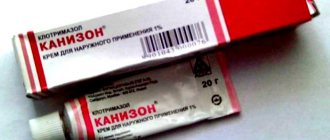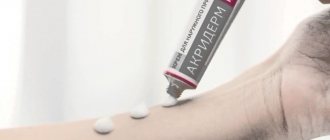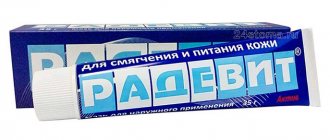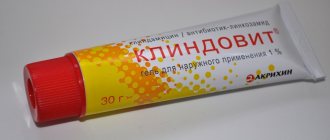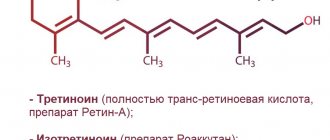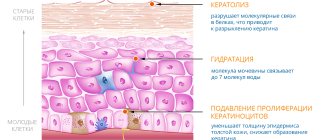Expert opinion
Lyudmila Sheveleva, pharmacist
Cycloferon is one of the most effective external agents that can destroy herpes viruses. Its active ingredient also copes with pathogens of fungal and bacterial infections in a short time. The drug is relatively safe and has no toxic effect on the liver, kidneys, or gastrointestinal tract. This differs from products containing acyclovir, which can negatively affect internal organs with long-term use.
The main purpose of using Cycloferon is to activate the immune response. After a course of treatment, the body's defenses are strengthened. Thanks to this, further relapses of viral, bacterial, and fungal infections occur much less frequently.
Composition and release form
Cycloferon liniment is a transparent, yellowish, thick jelly-like mass without a specific odor. The domestic manufacturer produces it packaged in 5.0 and 30.0 g in aluminum tubes. In addition to instructions for use, the large package includes an applicator for intravaginal administration. The active ingredient of the external agent is meglumine acridone acetate, formed from acridone acetic acid and meglumine. The auxiliary composition is represented by the following components:
- benzalkonium chloride;
- propylene glycol.
Cycloferon packaging and size difference
Cycloferon contains no fatty ingredients. Therefore, the ointment is quickly absorbed by the skin, evenly distributed in damaged tissues . Additional components not only form the basis of liniments. Each of them has antiseptic and disinfectant properties.
Pharmacological properties
Cycloferon gel is a powerful broad-spectrum immunomodulator. The drug exhibits pronounced antiviral, immunocorrective, and anti-inflammatory activity. After meglumine acridone acetate penetrates into the affected tissues, it stimulates the production of interferons. These bioactive substances induce certain cellular proteins that block viral replication. Epithelial cells and lymphoid elements of the mucous membranes produce sufficient amounts of interferons to suppress infection. Cycloferon also has other pharmacological properties:
- activates T-lymphocytes that destroy foreign proteins that invade the human body;
- relieves inflammation by activating neutrophils and stimulating phagocytosis;
- reduces the resistance of pathogens to the action of antibacterial, antiviral, and antimycotic agents.
The therapeutic effect of Cycloferon is based on strengthening local and systemic immunity. It increases the body's immunity to external and internal negative factors.
Works on external and systemic immunity
Drug interactions
According to the instructions for use, treatment with Cycloferon is permissible in combination with any drugs that are used in the treatment of the above diseases. Their list also includes interferons and chemotherapy drugs.
In addition, Cycloferon has the property of enhancing the effects of antibiotics, antiseptic and antifungal drugs.
Indications for use
The use of Cycloferon is practiced primarily in the treatment of viral lesions of the skin and mucous membranes. Less commonly, it is used to treat bacterial and fungal infections. The ointment is included in therapeutic regimens after diagnosing the following pathologies in patients:
- infection of the skin and mucous membranes with herpes viruses;
- urethritis and balanoposthitis, provoked by the activation of specific and nonspecific bacterial pathogens;
- vaginitis caused by staphylococci, streptococci, Escherichia coli.
Cycloferon is actively used in dentistry for the treatment of periodontitis. After a course of applying the ointment, it is possible to prevent the destruction of tooth ligaments and stop inflammation.
Liniment can be used as monotherapy. But for bacterial infections, it is combined with antimicrobial and antiseptic agents. A severe course of viral pathology requires the use of systemic drugs (tablets, capsules) with antiviral activity.
Directions for use and dosage
According to indications, Cycloferon liniment is used according to the following schemes:
- Herpetic infection - apply a thin layer to the affected area 1-2 times a day. Duration of therapy – 5 days. In the treatment of genital herpes, the drug is used daily in the form of intraurethral (intravaginal) instillations 1 time per day, 5 ml. Duration of therapy is 10-15 days. Liniment can be used simultaneously with other systemic and local antiherpetic drugs;
- Nonspecific and candidal urethritis - intraurethral instillations should be performed. The volume of the drug varies from 5 to 10 ml (depending on the level of damage to the urethra). In men with lesions of the upper urethra, the cannula of the syringe with the drug must be inserted into the external opening of the urethra, after which the opening is clamped for 1.5-3 minutes, and the instillation solution is evacuated by gravity. After half an hour, the patient is advised to urinate, since longer exposure may cause swelling of the urethral mucosa. Duration of therapy is 10-14 days. For lesions of the seminal glands and posterior urethra, intraurethral instillations through a catheter are used in a volume of 5 to 10 ml every other day. Duration of therapy – 10-14 days (5-7 instillations per course);
- Balanoposthitis – it is necessary to treat the foreskin and glans penis once a day in a volume of 2.5 ml. Duration of therapy – 10-14 days;
- Urethritis of a specific etiology - Cycloferon liniment is used simultaneously with specific antimicrobial drugs according to traditional regimens;
- Candidal and nonspecific vaginitis, bacterial vaginosis - it is possible to use Cycloferon liniment as monotherapy or simultaneously with other drugs. The drug is used in the form of intravaginal instillations 1-2 times a day, 5-10 ml. Duration of therapy is 10-15 days. In case of combined lesions of the urethral mucosa and vagina, daily simultaneous use of intraurethral and intravaginal instillations of 5 ml is advisable. Duration of therapy is 10-14 days. You can also use tampons soaked in liniment.
In the treatment of chronic forms of diseases, Cycloferon liniment combines well with the use of official medications (suppositories, vaginal tablets).
For intravaginal use, you need to open the tube and, after piercing the membrane with a disposable needle with a 5 ml syringe, draw in liniment, then remove and discard the needle. While lying down, a syringe with liniment should be inserted into the vagina and the drug should be squeezed out using a piston. If there is a vaginal applicator in the kit, you need to pierce the membrane of the tube and screw it onto the hole of the tube until it stops. The liniment must be squeezed into the cavity of the applicator, after which it is removed from the opening of the tube, inserted into the vagina and the drug is squeezed out using a piston. To prevent free evacuation of Cycloferon liniment, the vaginal entrance should be tamponed with a small sterile cotton swab for 2-3 hours.
Before using liniment during the treatment of chronic periodontitis, it is recommended to first rinse the periodontal pockets with an antiseptic, and then apply the drug to the gums with a cotton swab using the application method (do not rub in) in a volume of 1.5 ml (1/3 of the tube). Cycloferon liniment is used 1-2 times a day with an interval of 10-12 hours. Duration of therapy is 12-14 days.
If necessary, after 2 weeks for all indications, repeated courses of treatment are possible.
Contraindications
An absolute contraindication to treatment with Cycloferon is individual intolerance to its ingredients. It is strictly forbidden to use the ointment during pregnancy and breastfeeding. The manufacturer did not provide research results on the safety of drug therapy for children. Therefore, it is not used in pediatric practice. In the presence of severe pathologies of the liver and kidneys, immunomodulator therapy should be carried out with caution.
Be careful: there are contraindications
Contraindications and side effects
Contraindications to the use of ointment are:
- lactation;
- pregnancy;
- hypersensitivity of the skin to individual components of the ointment;
- the patient's age is less than 18 years.
Cycloferon practically does not cause adverse reactions. The exceptions are:
- isolated cases of mild allergic rash;
- mild burning sensation of the mucous membranes;
- hyperemia.
These effects disappear very quickly without medical intervention.
Instructions for use
The method of using the drug depends on the diagnosed skin pathology. According to the instructions for use of Cycloferon ointment, treatment is carried out in accordance with the doctor’s recommendations. He calculates single and daily doses taking into account the course and severity of the disease. The external agent is used in the following ways:
- to destroy herpes viruses, liniment is distributed in a thin layer on the skin up to 2 times a day;
- if the genitals are affected, the drug is used in the form of instillations once a day;
- fungal and nonspecific bacterial infections also require a single instillation during the day;
- for balanoposthitis, the head of the penis is treated once a day;
- To destroy pathogens of fungal and bacterial vaginitis, the ointment is used up to 2 times a day. It is used in the form of instillations or tampons for intravaginal administration are impregnated with it;
- During periodontitis therapy, applications with Cycloferon are performed 2 times a day.
For intravaginal administration, an applicator is used, which is also convenient for dosing the ointment. Before any treatment procedure, damaged tissues are pre-treated with antiseptics.
The duration of the therapeutic course of herpetic infection is 5 days. In other cases, treatment lasts about 2 weeks. In case of severe infection, the course is repeated after a short break.
Use for herpes for up to 5 days
Overdose
In clinical practice, no cases of overdose were observed due to the transformation of ingredients in the area of application of Cycloferon.
Side effects
Immediately after applying the ointment, especially to the mucous membranes, a slight burning sensation may occur. If it disappears on its own after a few minutes, there is no need to discontinue the external remedy. But sometimes burning is one of the symptoms of a local allergic reaction. It is accompanied by swelling and redness of tissues, the formation of rashes, pain, and itching. In such cases, it is necessary to quickly wash off the drug and seek medical help.
special instructions
Cycloferon is especially therapeutically effective in the initial stages of the development of any pathology. It should be applied to the skin at the first symptoms - burning, redness of the skin. This will prevent the formation of severe swelling and painful rashes.
If after 3-4 days of constant use of the ointment the intensity of the symptoms does not decrease, you should consult a doctor. He will clarify the diagnosis and, if necessary, make adjustments to the therapeutic regimen. Doses may be increased, additional drugs may be prescribed, or Cycloferon may be replaced with a more effective drug.
To avoid self-infection, it is necessary to follow the rules of hygiene during therapy. Before applying liniment, wash your hands thoroughly with warm water and soap. The applicator and tube neck should be treated with antiseptic solutions after each use.
What antiseptics are there (from the first aid kit)
Storage conditions and periods
The shelf life of liniment is 24 months. After opening the tube, it is limited to 4-5 weeks. Cycloferon should be stored at room temperature in places protected from direct sunlight. The ointment is not used for treatment if it separates, changes color or smell. Small children should not have access to the storage area of the drug.
Conditions for dispensing from pharmacies
When purchasing Cycloferon, you do not need to present a prescription from a doctor.
Drug interactions
Liniment is compatible with any local and systemic agents used in the treatment of infectious pathologies. But it must be taken into account that it increases the therapeutic activity of antibiotics, antimycotics, and antiseptics.
pharmachologic effect
Cycloferon liniment has pronounced antiviral, anti-inflammatory and immunomodulatory properties.
1 ml of ointment contains 50 mg of meglumine acridone acetate, 38.5 mg of N-methylglucamine and excipients. In the early stages, the drug is able to suppress the reproduction of cytomegalovirus, herpes viruses, papilloma, human immunodeficiency and other viruses.
The active antichlamydial, antibacterial and antifungal effect of Cycloferon liniment ointment is due to the ability of the drug to stimulate the main immune systems, inducing early alpha interferon.
Cycloferon liniment, reviews confirm, is effective as a component of immunotherapy in the treatment of chlamydia, fungal and bacterial infections of the genitourinary system, as well as other chronic and acute bacterial infections.
In addition, Cycloferon liniment is widely used for the treatment of chronic periodontitis, due to its ability to suppress the growth of pathogenic microorganisms and normalize the level of secretory immunoglobulin A in the fluid of periodontal pockets.
The use of this drug can improve oral hygiene, reduce tooth mobility, reduce bleeding gums, and get rid of bad breath.
Analogs
Cycloferon ointment has no structural analogues. Viferon has a similar composition, which is available in the form of suppositories and gel. Acyclovir and its imported analogue Zovirax, Interferon, and Panavir also have an antiviral effect. Oxolinic ointment, which is often used for preventive purposes, is cheaper.
There are no analogues in composition
